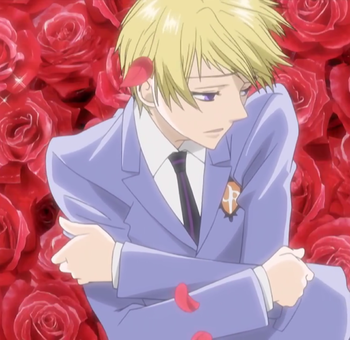A popular Asian character type, the bishōnen, or "beautiful boy", is a male character that possesses androgynous or "feminine" physical traits. He is usually tall, slender with almost no fat and little to no muscle, and no body or facial hair. Large, expressive eyes are almost a given, though Tsurime Eyes are also common in more serious examples. In anime, many bishōnen have female voice actors, although those that don't will instead get startlingly deep, sexy voices. It is not uncommon for those at the more feminine end to be mistaken for women by other characters, or for savvier examples of the type to take advantage of such an assumption.
Bishōnen can be found equally distributed between heroes and villains; bishōnen villains often develop devoted followings among fans. Bishōnen with white hair are almost always villains, no matter how they initially seem.
The broader equivalent to this trope would be the Pretty Boy, which covers similar territory in terms of raw attractiveness but can be older and doesn't necessarily cross any androgynous line. Indeed, the Pretty Boy is often an accusation of being too attentive to their own appearance, whereas the Bishonen just rolls out of bed looking like they do.
In the English fandom, the term bishōnen simply connotes "a really, really attractive male", but in its original usage, it refers to a specific type of attractiveness that is found in adolescents. The cutoff for bishōnen in the strict sense is around 20 years old. Beyond this age, the Japanese describe male attractiveness through terms like biseinen or bidanshi ("beautiful man") or ikemen (roughly "good-looking guy"). The affectionate English fandom shorthand "bishie" bypasses the lexical issues somewhat. Examples of both bishōnen and biseinen should be placed on Pretty Boy. Likely to have drawn on a moe aesthetic when they were younger.
The comparable Korean concept is kkot-minam ("flower pretty boy").
The appearance and behavior of the archetypal bishōnen is often used to explore sexuality and gender norms. Thus, guys in the Yaoi Genre have a tendency to be this.
Originally, bishōnen characters were the province of Shoujo and Boys Love Genres, but since the mid-90s, it has become the default style for teenage boys in pretty much any work looking for a cross-demographic audience. Since more modern anime and manga are overwhelming geared towards appealing to both men and women in this respect, a large majority of virtually all mainstream works will feature at least one bishōnen character, if not more. Also, the farther bishōnen characters disseminate from their source genres, the less likely it becomes that there will be in-universe mention of their androgynous looks/attractiveness.
Older Than Print, since The Tale of Genji frequently describes Genji himself as one. Often comes with the Bishie Sparkle. If all the guys are bishōnen without many women to balance them out, you've got yourself a Cast Full of Pretty Boys.
Do not confuse with Dude Looks Like a Lady; while some Bishōnen may be androgynous enough to look like ladies, not all Dude Looks Like a Lady count as Bishōnen. If the boy, in particular, is more girly cute than androgynously handsome, they probably don't count as Bishōnen.
Related to Rule of Glamorous. The Long-Haired Pretty Boy is a standard bishōnen design.
Contrast Gonk, The Grotesque, and Puni Plush. Also, contrast Hunk which can nonetheless cross over with this trope, such as for Vega from Street Fighter, as well as Bara which is similar to Hunk but it has a good amount of fat somewhere. Pretty girls are known as Bishoujo ("beautiful girl"), but the aesthetics of bishoujo are different, typically emphasizing cute, petite femininity rather than sleek androgyny. See Bifauxnen for ladies who conform a bit more closely to the bishōnen aesthetic. Not to be confused with the Bishōnen Line.
See Pretty Boy for examples.

